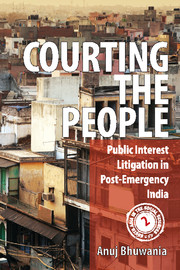Book contents
- Frontmatter
- Contents
- Acknowledgements
- Introduction
- 1 Competing Populisms: Revisiting the Origins of Public Interest Litigation in India
- 2 The Case that Felled a City: A PIL with Nine Lives
- 3 Public Interest Litigation as a Slum Demolition Machine
- 4 Good Judges, Bad Judges: Critical Discourses on Public Interest Litigation in India
- Conclusion: The Procedural is Political
- Bibliography
- Index
1 - Competing Populisms: Revisiting the Origins of Public Interest Litigation in India
Published online by Cambridge University Press: 23 July 2017
- Frontmatter
- Contents
- Acknowledgements
- Introduction
- 1 Competing Populisms: Revisiting the Origins of Public Interest Litigation in India
- 2 The Case that Felled a City: A PIL with Nine Lives
- 3 Public Interest Litigation as a Slum Demolition Machine
- 4 Good Judges, Bad Judges: Critical Discourses on Public Interest Litigation in India
- Conclusion: The Procedural is Political
- Bibliography
- Index
Summary
It is by no means merely a matter of misguided theory that the French concept of le peuple has carried, from its beginning, the connotation of a multi-headed monster, a mass that moves as one body and acts as though possessed by one will; and if this notion has spread to the four corners of the earth, it is not because of any influence of abstract ideas but because of its obvious plausibility under conditions of abject poverty.
—Hannah Arendt, On RevolutionThe Indian Supreme Court is widely considered the most powerful judicial institution in the world. The rise in its power follows the reconfiguration of Indian political life in the aftermath of the Emergency of 1975–77. In the last 35 years, it has acquired a central role in Indian public discourse. The principal means by which the court has acquired its new importance is the phenomenon of ‘Public Interest Litigation’, or more commonly PIL – a term that is too easily translated into its American (and hence ‘global’) counterpart but in fact has little in common with it. PIL is a unique feature of the Indian appellate judiciary. It is not simply pro bono lawyering, something that a certain tribe of lawyers do, like in the United States. In India, PIL is a jurisdiction – that is, what some judges are empowered to do in a specific capacity provided or interpreted in the law. As Canadian scholar Jamie Cassels wrote in 1989, ‘Unlike the case of public interest litigation in Canada or the United States, the legal aid/public interest movement in India has been almost entirely initiated and led by the judiciary.’
The Indian form of PIL jurisdiction was born in the immediate aftermath of the Emergency, through the ingenuity of the Supreme Court commonly seen as trying to undo the legacy of its capitulation to the political rulers of that period. PIL, right from the start, was marked by impatience with technical formalities and a key rhetorical mode increasingly deployed by judges: arguments made in the name of ‘the people’. In other words, the court redefined itself as the fount of substantive justice: portraying itself as the ‘last resort for the oppressed and bewildered’.
- Type
- Chapter
- Information
- Courting the PeoplePublic Interest Litigation in Post-Emergency India, pp. 16 - 49Publisher: Cambridge University PressPrint publication year: 2016
- 1
- Cited by



